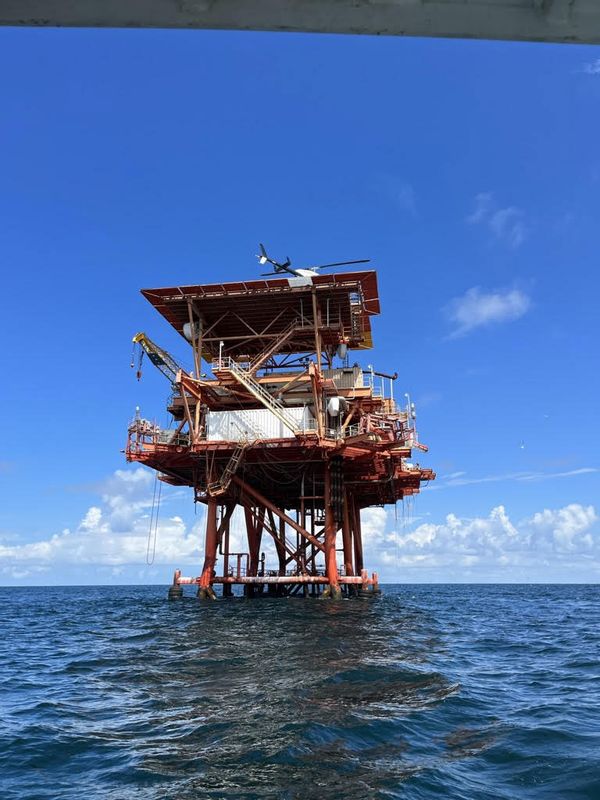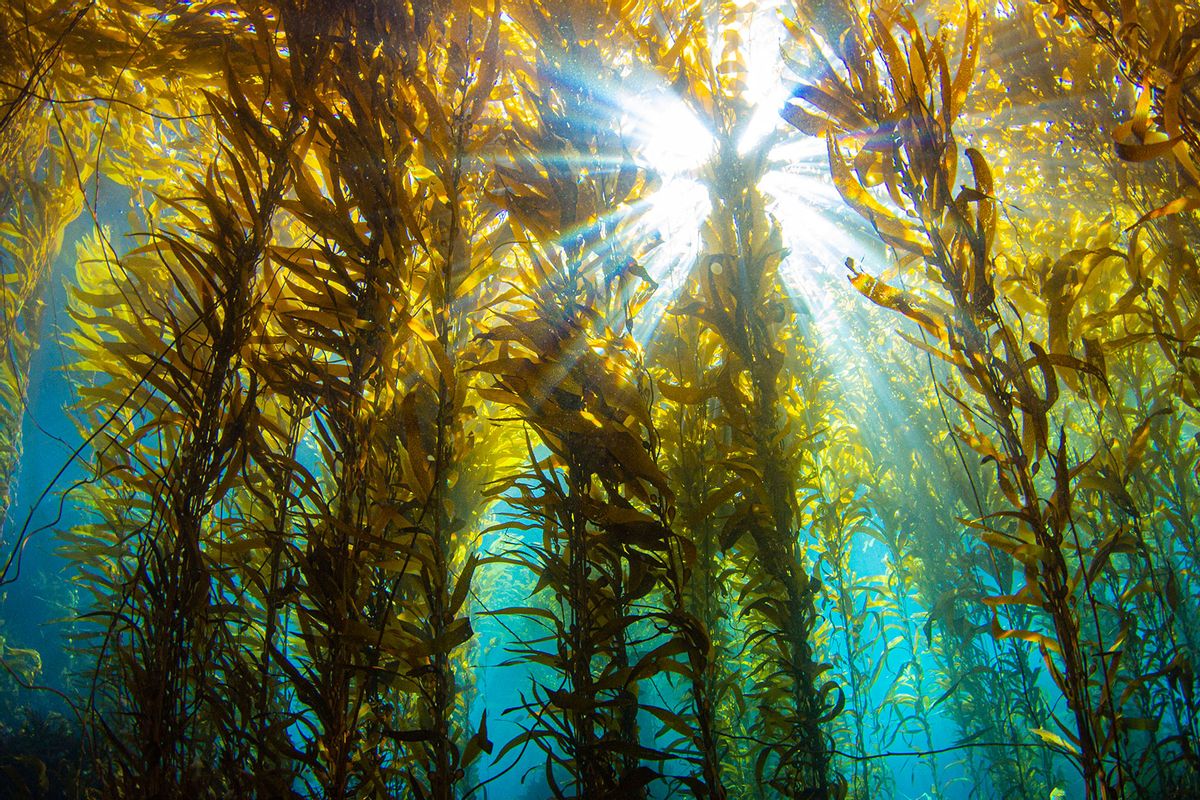As Big Agriculture continues to dump fertilizer and other cattle ranch runoff into the Gulf of Mexico, our aquatic systems suffer. Algal blooms wind up flourishing, killing fish and shellfish alike while causing eye and respiratory illnesses in humans. In addition, the dumping of this pollution into the Gulf of Mexico creates "dead zones," or areas of the ocean where the oxygen is so low that life struggles to survive. Like so many other problems, the pollution in the Gulf of Mexico seems at times to be insoluble. A recent report found that while the dead zone there seems to be shrinking, it's still about the size of Yellowstone National Park, roughly 3,058 square miles.
"It's like a fertilizer hose dumping out into the northern Gulf of Mexico."
Yet Kent Satterlee III, executive director of the Gulf Offshore Research Institute (GORI), believes that he may have come up with a solution that will at the very least take a big bite out of this problem: Using abandoned oil rigs to grow seaweed.
"Seaweed needs three primary nutrients in addition to sunlight to flourish — nitrogen, phosphorus, and carbon dioxide," Satterlee told Salon by email. "The Mississippi River outflow is high in these nutrients due to fertilizer and cattle ranch runoff, which cause algal blooms in the Gulf of Mexico and subsequent hypoxic conditions or 'dead zones,' where low oxygen levels impact marine life." He added that previous researchers had previously found that Mississippi River seaweed had removed "large quantities of these nutrients from coastal ecosystems."
"Seaweed is harvested in many tropical areas around the globe, mostly in Southeast Asia," Satterlee said. "The high nutrient levels in the Mississippi River combined with the use of retired offshore platforms make for an excellent combination to farm seaweed in the Gulf. There are currently about 1,600 platforms in the Gulf, with about 400 ready for retirement. The use of offshore platforms enables the farm to mechanize much of what is currently being done by manual labor around the world, and seaweed can be grown in combination with other aquaculture species such as finfish and bivalves."
 Offshore Platform Being Repurposed in the Gulf of Mexico ( Kent Satterlee/Gulf Offshore Research Institute (GORI))
Offshore Platform Being Repurposed in the Gulf of Mexico ( Kent Satterlee/Gulf Offshore Research Institute (GORI))
Yet Satterlee cannot do this work alone, and that is where researchers like Dr. Sarah Taber enter the picture. She has a DPM, or Doctor of Plant Medicine, from the University of Florida, and specializes in studying agriculture. Taber can be found on Twitter promoting the project with zeal. Describing it as "fun" and the abandoned oil rigs as "Mad Max but wet," Taber spoke with Salon at length about what it is like farming seaweed to save an ecosystem — or, as Taber calls it, "the coolest ag project of all time."
This interview has been lightly edited for clarity and length.
Want more health and science stories in your inbox? Subscribe to Salon's weekly newsletter Lab Notes.
"The real solution is to stop dumping all over Iowa, but the farmers, they aren't going to do that."
On your Twitter feed, you said that "the highest density of old about-to-retire rigs-lines up with the dead zone caused by nutrient runoff. The idea is seaweed farming can clean up the water." Can you explain the science behind this?
Basically, all these hog farms from Iowa on down end up in the Mississippi River. They fertilize a lot and they also just dump a lot of manure onto their fields, in excess of what plants can actually use. And they also tend to do it in winter. So the Mississippi River, like all rivers, tends to get really fat with snow melt and all that stuff in the winter and early spring. So the Mississippi gets huge. It's full of all the snow melt that's laden with feces, basically. So you have a whole lot of nutrients, a lot of nitrate and a lot of phosphate coming out the river. It's like a fertilizer hose dumping out into the northern Gulf of Mexico.
So what will happen is, you get a bunch of algae blooms in the spring and summer because of all this high nutrient density. These algae will grow and block out all the light so nothing can grow on the bottom. And then they use up all the nutrients, and they die en masse — and as they decompose they suck up all the oxygen. So you wind up with something they call the dead zone in the Gulf of Mexico.
This is a really well known phenomenon in crop science. The real solution is to stop dumping all over Iowa, but the farmers, they aren't going to do that. So another way is to try and clean it up. This is for all the seaweed and it just so happens that's also a big oil extraction area, so we also have a lot of rigs — some that are reaching the end of their working life — so it's just kind of a nice coincidence that we have infrastructure there that can help form seaweed to clean it up.
The next question is also related to your Twitter feed. You say bivalve and deep water coral reefs grow over the rigs' legs, yet reefs are otherwise hard to come by in the Northern Gulf. Why is that the case?
"There used to be a lot of oyster reefs off of Louisiana and other places in the Gulf, but they've been kind of demolished in most of the U.S."
Because it's a river basin, you have this Mississippi River dumping a lot of sediment and it's just been doing that for millions of years. The Northern Gulf of Mexico is just kind of a mud bowl. So you don't have rocks buried under a lot of sediment, so a lot of marine organisms like oysters and corals, they don't want to grow on mud. They know if there's mud here it's because there's a river or something dumping mud. And if I grow here, I'm going to get covered up by it, I'm going to get smothered. So their larvae will only settle on hard surfaces, not mud. So if you're in the Northern Gulf of Mexico, the only place these critters are going to settle is on a hard surface. The only hard surface is oil rigs in that particular location.
There used to be a lot of oyster reefs off of Louisiana and other places in the Gulf, but they've been kind of demolished in most of the U.S. So there used to be places that had hard surfaces and now rigs are what's left. So we're doing rehab.
You've said these places are some of the best places to catch high quality fish like red snapper and swordfish. Why is that?
Because those fish like to hang out on reefs, and those are the only reefs.
You've also said these seaweed farms would create jobs. How so and how many jobs do they think it could create?
Someone has to plant [the seaweed] and harvest it, right? That depends on how much like this actually takes off. If you only get one experimental rig out there, you might have maybe two to five people working at a time. But if it turns out to be economically really useful and we're able to build a big seaweed industry — we haven't sat down and done the employment math, but you can generate billions of dollars worth of economic activity.
How can someone from a conventional background in terms of agriculture, what you're working on now, transition to seaweed? What is that like in terms of the discipline? Is it the same basic concepts or is it a completely different?
"The bulk of the world's seaweed that is being farmed is just farmed entirely by hand in China and Southeast Asia."
There are two answers to that. The conventional agriculture background applies because we had to figure out how to automate a lot of things. And the way people are currently farming seaweed, it's entirely hand-harvested. If you're talking about all the hand growing that's happening in China, like the bulk of the world's seaweed that is being farmed is just farmed entirely by hand in China and Southeast Asia. Folks who are trying to do it in wealthier countries, usually are using kelp because they're further north and it's cold. Go to YouTube, search for videos of people harvesting kelp. It is a dude in a boat pulling a rope outta the water and slicing the kelp off with a knife. That's crazy, right? We don't have to live like this anymore.
So that's where the conventional agriculture background comes in, as we are very used to automating processes. Obviously we don't do it where there's a lot of salt and wind and waves, but we're used to rugged outdoor environments in general. That's what I'm there for. I've already looked at a couple of the processes we need to automate and I said, "Well, here's a piece of equipment we use on farms, that actually would probably a pretty good fit for cutting this vegetation and holding it as it comes off." That's kind of been my role.
Then the second thing is, I did a lot of weird stuff in terrestrial agriculture, like I worked with a lot of aquaponics, which everybody thought was way too weird to commercialize, but I actually got one of my clients to a pretty nice commercial scale. It's called Superior Fresh. They were actually just featured in Science magazine. They're poised to expand. So that was a really novel technology.
Everybody said we've actually done it commercially in a viable way and I helped it happen. I've worked with a lot of just novel technologies, indoor agriculture as well. If you follow the indoor agriculture industry at all, a whole bunch of them are collapsing and folding lately. But not my clients, because I helped them really early on get a good logistical setup and do their food safety work, like set up their process so they can get a food safety audit so they can actually sell their crops, which a lot of indoor farms didn't do and now they're suffering the consequences. So I actually worked with a lot of novel agricultural technologies.
We need your help to stay independent
That is interesting. And I suppose the question then becomes, what made you decide to invest in this project in terms of your time?
It's cool. I think seaweed farming is the thing I've been interested in for a long time. It was kind of hard to get involved as a crop scientist because it's usually people who do marine engineering who are involved, which totally makes sense because the main problem is how do we set up a system of ropes that's going to hold up the seaweed and not collapse.
But then you also have to consider like, can we actually get a boat in there to harvest it? Because the mindset they've been having so far is, we're just going to have a guy in a dingy with a knife, right? You don't have to think very carefully about how you design it, you just have to get a guy with a dinghy in there. But if you're going to go to a larger scale, like growing up seaweed to clean up the Northern Gulf of Mexico, you're looking at some bigger rigs. So you have go to think a little bit more logistically about how I'm going to pull that off, how you're going to automate it. So I just ran into these guys at the right place at the right time, really.
Read more
about the environment:

Shares